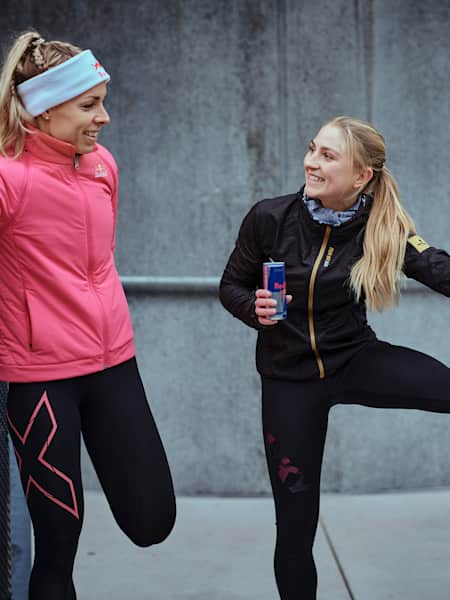Whether you’ve just run the Wings for Life World Run or any other running event, focusing on rest, hydration, and nutrition is key to supporting your body. Building a running recovery routine based on key pillars sets will set you up for healthy habits. So here are nine essential running recovery tips to help you get stronger and rebound faster.
01
Stay hydrated
Proper hydration keeps muscle cramps at bay while replenishing the fluids and electrolytes you continue to lose after your run ends. But there’s something to say about what you drink, how much you drink, and how you drink it.
Sure, drinking plenty of water is part of the equation, but think beyond plain cold water for running recovery. For best results, look for ways to replenish the electrolytes your body sweats out during physical activity. This could be a sports drink, oral hydration solutions, coconut water, or simply adding salt to your water before, during, and after workouts.
Staying hydrated is important before, during and after the race
© Alex Grymanis/Red Bull Content Pool
All this said, even if you’re very thirsty, be careful not to chug. Slower sipping ensures you’re replacing what you continue to lose post-run.
02
Focus on nutrition
High-protein snacks rich in essential amino acids support and speed up the muscle protein synthesis process that builds and maintains muscle. Pairing these proteins with complex carbohydrates replenishes the glycogen spent during your run, enabling your body to repair and rebuild. Unsaturated fats are also part of a runner’s ideal diet.
Edamame, hard-boiled eggs, nuts, and hummus are just a few examples of grab-and-go high-protein snacks you can reach for after a run. Don’t rule out a shake with protein powder either if smoothies are more your speed.
If you have time for a meal after your run, build a protein-packed plate with chicken, fish, or tofu as the star. Add a healthy grain on the side, like quinoa, for your carb intake. Timing makes a big difference, too; eat a few hours after your run to maximise your running recovery benefits.
03
Stretch, stretch, and stretch some more
Stretching is integral practice for ultrarunners like Tom Evans
© Markus Berger / Red Bull Content Pool
Post-run stretching increases blood flow to your muscles. This stretching opens up the blood vessels around the body part you’re focusing on, which lets more blood through and yields anti-inflammatory effects. It also helps reduce muscle soreness, also known as delayed onset muscle soreness (DOMS). This is the scientific term for the pains and aches you can experience in your muscles and joints after running.
Dynamic stretches — those that involve motion — before your run can lower your risk of injury. Static stretches — those with no motion — can fend off DOMS. Professional runners make ample time for both.
04
Break out the foam roller
Štefan Svitko foam rolls to help prevent soreness and muscle tightening
© Filip Nagy / Red Bull Content Pool
It’s not just your muscles that need a break for proper post-run recovery — your myofascial tissue needs some TLC, too. This thin layer of tissue across your body is key to supporting your range of motion, flexibility, and comfort. Too tight, and you can feel stiff and sore after a run.
Enter foam rollers: these at-home devices let you loosen these tissues yourself in a process called self-myofascial release (SMR). Studies on long-distance runners have found that engaging with SMR significantly proves muscle flexibility. Make some time in your recovery for foam rolling your thighs, hamstrings, and glutes, among other areas.
05
Don’t skip sleep
Sleep is how your body repairs itself, muscles included. A lack of sleep may correlate to a spike in the stress hormone cortisol and reductions in insulin-like growth factor 1 (IGF-1) and testosterone levels. These three factors can get in the way of optimal muscle recovery. Prioritising healthy sleep habits will go a long way if you want to beat your PB.
"Sleep is extremely important," emphasises endurance specialist Michael Strasser. "If you don't sleep properly, you'll be pretty flat pretty soon." The best recipe for getting extra sleep, according to Strasser, is a short nap right after physical exertion. If you can't squeeze that in, you should make sure that you at least get enough sleep at night. Another important factor is the quality of sleep. The higher the quality of sleep, the greater the regeneration.
The importance of prioritising consistent, quality sleep to improve endurance has been proven time and again in studies. This includes a 2021 Journal of Strength and Conditions Research study and another study published in Medicine & Science in Sports & Exercise (MSSE) in 2019. Most experts recommend getting seven to nine hours of sleep per night, with the 2019 MSSE study recommending a minimum of eight hours per night.
06
Try an ice bath
Alternating between warm and cold plunges can be a key part of athlete's post-sprint recovery. Embracing frigid temperatures can reduce inflammation and soreness after training or competing. While studies are still being conducted on the efficacy of ice baths, also called cryotherapy or cold water immersion, many elite athletes swear by them.
Safety is key during an ice bath — direct skin exposure to freezing temperatures can be dangerous. Experts recommend wearing shorts and a t-shirt during your ice bath and having warm clothes available to step into immediately afterward. This way, you quickly bring your body back up to a stable temperature while still enjoying the potential benefits of ice baths. Your ice bath should last no longer than 15 minutes, and drinking a warm beverage afterward may help too.
07
Try cross-training
Kate Courtney does yoga to prepare for the cross country season
© Paris Gore / Red Bull Content Pool
Yes, exercising on off days can still be part of recovery, or in this case, active recovery. This practice involves engaging your body in different and more gentle ways, so you’re still exercising but giving your knees, legs, feet, and hips that much-needed break. Yoga and swimming are great cross-training examples for runners — they engage your body without demanding too much stress on your joints.
08
Build recovery into your routine
Just like any good habit, making recovery part of your running ritual is key to developing a routine that sticks. Ensure you allow yourself enough time to stretch, foam roll, do some yoga, and grab a bite to eat. Give yourself a rest day too — one day off every seven to 10 days can lower your risk of injury. If this feels unusual for you, know that practice makes perfect. Create a routine you can stick to, and find ways to make your new habits work for your lifestyle.
09
Listen to your body
Pushing through pain can have unintended long-term consequences. Repetitive stress injuries like runner’s knee and plantar fasciitis are common. However, you can prevent them if you learn to sense what feels normal for your body and what seems out of the ordinary. Be on the lookout for signals like consistent pain or swelling. If they don’t get better on their own, seek an evaluation from a medical professional or training specialist. A coach, physical therapist, or sports medicine professional can get your recovery back on track.
Part of this story











